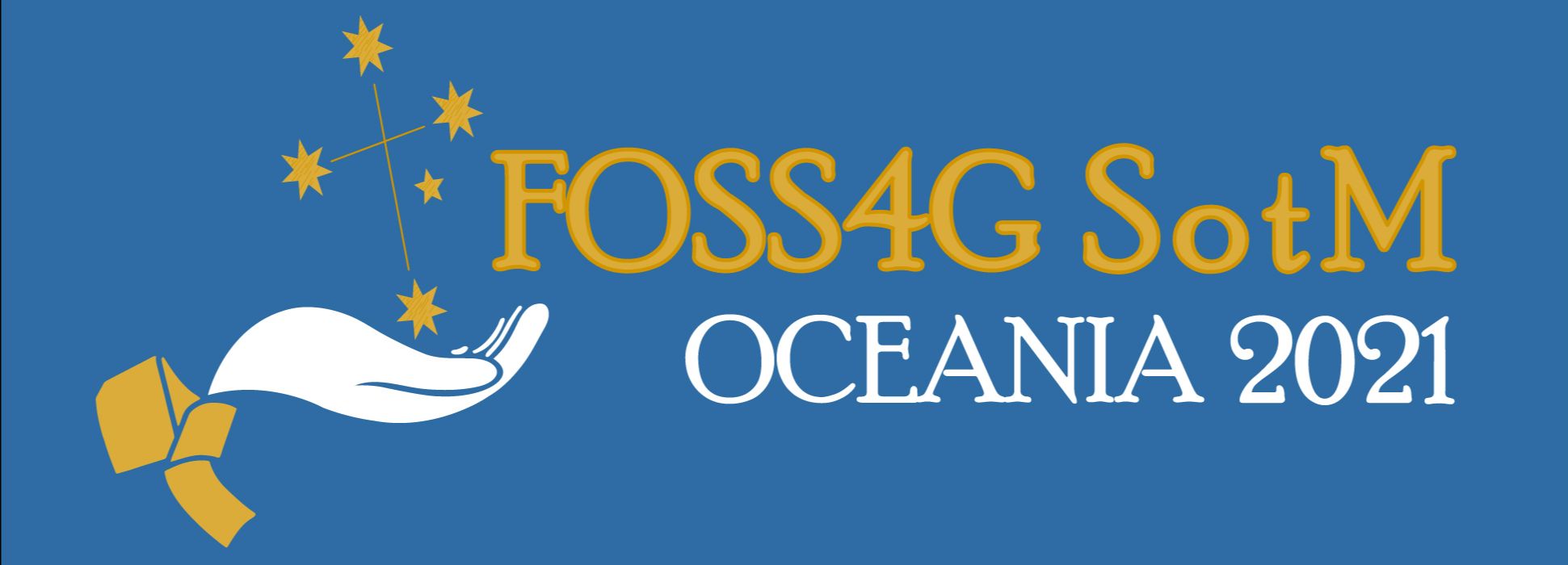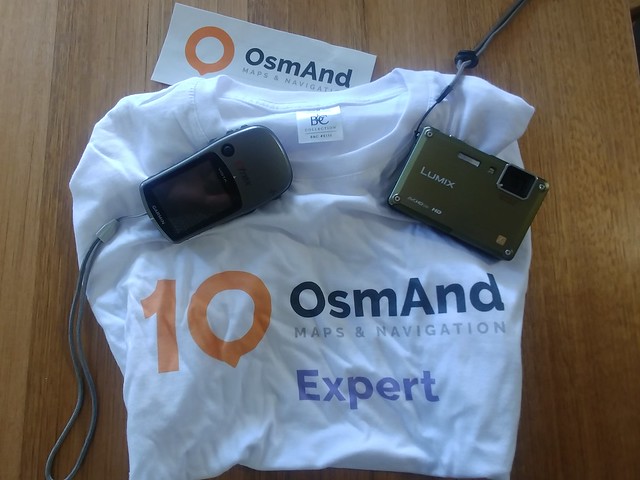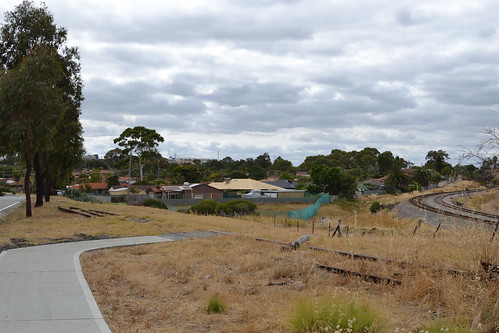This morning was our first (ever?!) OpenStreetMap meetup in Perth, Western Australia. Six of us turned up at the Goods Shed cafe (near the railway station) for introductions, coffee, and a general figuring-out of a plan. Then we headed off in small groups around the local area, mapping footpaths, shops, businesses, trees, drinking fountains, and everything else we could find.
Sam Wilson's Diary
Recent diary entries
FOSS4G SotM Oceania 2021 — Perth Hub 12–13 November
Posted by Sam Wilson on 22 October 2021 in English.The FOSS4G SotM Oceania Perth Hub conference program has just been announced, with a few things about OSM (including a small talk by me, but I’m not promising anything amazing!). The bit I’m most excited about is an OSM workshop all day on Saturday the 13th: everyone should come along, with laptops, cameras, and GPSs (or just a phone), and learn to edit the map!
The City of Fremantle has new speed limits, mostly 40km/h. I’ve been trying to get the map up to date. They provide a bit of a map (archive), and I’m checking against the new signs as they go up. I don’t know why they don’t care about what happens west or north of the railway line.
I normally don’t really care about vehicle speed limits, because I don’t drive, but this was an interesting exercise in JOSM filters and non-geometric mapping.
The other day I received a cool new t-shirt and sticker, from OsmAnd. This really is my favourite bit of software on my phone, I think. For about the last five years, I’ve not used any other mapping or navigation app, even when travelling far away places (and even when there’s not actually that much data on the map!).
The GPS and camera and the things I use when mapping, along with a spiral-bound notebook with a pen stuck in it.
(The location of this post is not actually where I am while writing it, but it’s the last hill I mapped and feels like a good place to fly the OsmAnd flag.)
Gosh, the spammers are going for it at the moment on the OSM diaries. :-(
Thank you to everyone who’s handling the deleting of it!
Unfortunately, my feed reader sucks all the bogus entries in before they’re deleted, so I’ve got hundreds of Chinese spam posts (marked as Bengali for some reason), drowning out the interesting stuff. I’d switch to just the English feed, but am getting things via https://blogs.openstreetmap.org/atom.xml so there’s no option for that, and I don’t want to miss the other syndicated blog posts.
Maybe I should just head outside with a GPS… :-)
I’ve been meaning to add this path to the map for months, but I’m glad I went and checked it out in person because my memory of it is from the 1990s — and it’s changed a bit:
I’ve been enjoying the Notes features of OsmAnd, both for adding new ones and even more for finding nearby ones when I’m out and about. Every OSMer should tell all their friends to lodge notes! :-) I’ve been training everyone I can (two people so far; maybe I need more friends).
I also only recently noticed that people near where I live are actually leaving notes (they weren’t last time I looked a year or two ago.) Which is great, and I’m trying to fix them all. Many seem to come from MAPS.ME, and sometimes are in the wrong spots or are spurious (most commonly saying a thing is gone when it’s not). But more are useful than aren’t.
So I’ve added the RSS feed of notes for this area to my normal daily news aggregator, and hopefully will do a better job of keeping up to date with people’s corrections and spam.
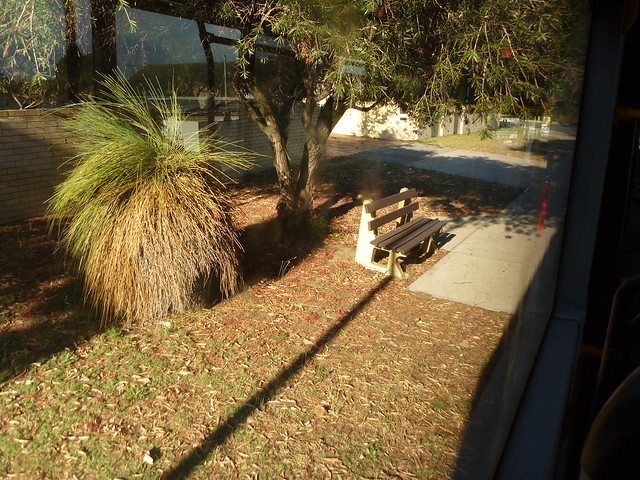
I’ve been out mapping the 158 bus route to Perth. It’s not as easy as I’d hoped. Hard to get every stop! Harder still to get their numbers (although, I’m not sure how useful those are anyway).
I’ll attempt to add some more, and keep track of them on the Perth wiki page.
[Photo, all photos]
I can’t believe I’ve been walking past this construction site and now new roundabout for about two months, and it only just occurred to me this morning that I should update the map!
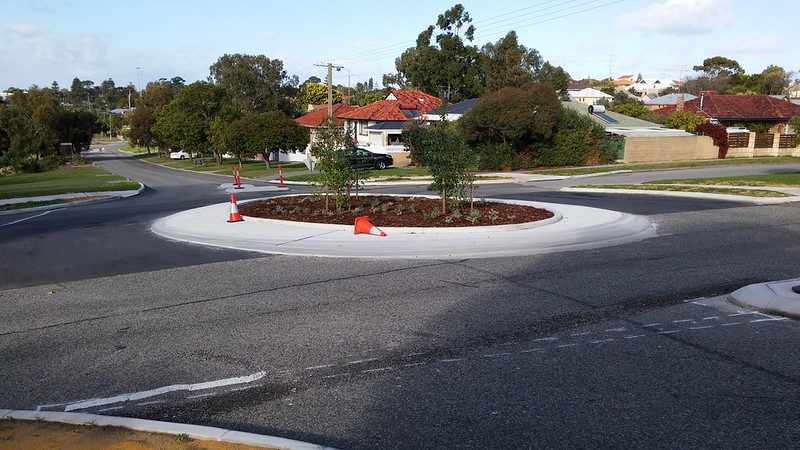
Anyway, done now.
New data sources available for Western Australian roads
Posted by Sam Wilson on 13 December 2016 in English.The Main Roads department of Western Australian recently released quite a few datasets under the Creative Commons Attribution licence. We have explicit permission to use two of these in OSM: the Road Network (MRWA-514) and Road Hierarchy (MRWA-515).
I’m part of a local geogeeks group that meets fortnightly in Perth, and with the help of some people far more knowledgeable than me about spatial stuff I’ve been attempting to derive a comparison between the Main Roads data and what’s already in OSM. That’s a work in progress (eventually it’ll spit out an OSM file containing only correctly-attributed roads that are missing from OSM), but for the time being I’m going down a much more manual route:
1. Download shapefile from the data.wa.gov.au site linked above
2. Use ogr2osm to convert it to OSM format:
python ogr2osm.py RoadNetworkMRWA_514/RoadNetworkMRWA_514_1.shp -o mrwa514.osm`
3. Create a JOSM style file that makes the names stand out:
way[cwy=Single] {
text: auto;
width: 3;
color: #c0c0c0;
text: "road_name";
text-position: line;
text-offset: 14;
font-size: 16;
font-color: lightyellow;
}
4. Mostly, road geometry is actually already in OSM, but the names and road types aren’t. To make it easier to find where to work, I apply filters in JOSM to hide everything apart from roads with no names. Then it’s just a matter of clicking a road, adding its info, and as soon as it’s got a name it disappears (thanks to the filter).
This is still pretty slow, but it’s safe. I’m sure there’s going to be lots of better ways to work with this, but at least some missing names (and geometries) are being fixed.
I’ll use source:name=Main Roads Western Australia to designate where the name has come from. The geometries I’m double-checking against Bing.
I’m on the move at the moment, currently in Spain visiting Menorca and Mallorca, and have been using OsmAnd on my phone a lot. It’s a great program! Especially the bus stops and routes. I just want to say thank you to everyone who’s mapped these things; it really is worth it! And using OSM data in this way has given me more enthusiasm for contributing more transport data in my home town.
The only drama I’ve had with OsmAnd is the GPX-recording, and really that was my fault. For some reason I thought I’d hit ‘stop recording’ before ‘save’… and lost my whole day’s travels. Still, at the least the photos I was taking were safely geocoded (and now on Flickr). From now on I’m going to stick to my trusty old Garmin Vista HCx and proper camera.
I’ve made some small edits to the map, and will try to do more. There’s one bit that I’m not sure about, that I shall leave to mappers more au fait with the area than me; I’ve left a note for that.
I did add my grandparent’s old house, Ca’n Ding Ding (nice name eh?)—
I went for a walk yesterday, to see what I could see:
I was not stopped by this sentry (‘though she was about 100 mm long so I did duck off around the other side of the shrub):
I don’t suppose it’s of use to many people, but in the interests of adding to the list (somewhere) of software-that-supports-OSM, here’s one more: http://samwilson.id.au/2015/07/23/tabulate/
Or on the WordPress plugin directory: https://wordpress.org/plugins/tabulate/
Finding a small bit of an old railway line
Posted by Sam Wilson on 2 January 2014 in English. Last updated on 4 January 2014.I didn’t know it when I went out this morning that I was on an expedition to find the old Spearwood railway junction. (Isn’t that the whole point of this sort of ramble though? Not knowing. Although, it’d be nice to know what’s not known in OSM I guess…)
On the way, I filled in a few more street names, and took some more photos of market gardens that are almost certainly soon to be “redeveloped” and never seen any more. A nice morning, and far better than being at work. (Ha! A whole nother week to go yet of the hols!)
The northern part of the walk was reasonably dull (by which I do not mean to imply that it was not enjoyable, just not interesting; dull walks are sometimes the most fun… if you see what I mean? Xavier de Maistre would get it perhaps. But then again, perhaps not.) There was a leaky footpath though.
I think there must be a very large number of GPS trace points at the intersection of the equator at the prime meridian (what’s that place called anyway?).
I’m afraid I’ve been fool enough to add quite a few of these myself! Oops. Sorry.
I’ve modified one of the gpsbable scripts that I use to prepare NMEA files, chopping out anything around (0,0), so all should be fine from now on.
A bit over a year ago I started uploading weekly dumps of the GPS traces from my company's fleet. I've uploaded a bit over half a gigabyte of data since then, or 20,000 to 50,000 points per week, and party render thinks it looks like this:
![]()
python render.py -d .. -g none -r 1000 --pos=-32.901318,117.776609
I trace over bits and pieces now and then, but I'm not doing much. I was just wondering whether anyone else is mapping in rural Western Australia and finding these traces useful?
I have recently been given permission from the company that I work for to upload the GPS traces from our fleet of vehicles. These are twenty or so trucks and 4WDs that travel the length and breadth of the south-west of Western Australia, often along small roads and farm tracks, etc. They each have a GPS tracker taking readings at 30s intervals and sending these (when possible; there's a delay when out of range) back to a central server via the GSM network.
I get hold of these traces as week-by-week NMEA files (containing all vehicles' data), and convert them to GPX with this gpsbabel command. Then I upload them. They're about 15000-20000 points each.
I'm going to try to get the sampling frequency increased, because there's lots of areas for which these points are too far apart. Although, I guess as the density of points increases (i.e. from multiple trips along the same roads) the topography will become clearer.
Now, the tracing begins! :-) If anyone wants to help....
I quite enjoy tracing suburban footpaths.
One of the things that turned me off OSM back in the beginning (a few years ago; I can't quite remember when) was its seeming focus on making maps for CARS. I don't like cars! I cycle, or walk, and don't have a driver's license; I want to contribute to maps for walkers and cyclists, not for those silly GPS things that everyone's suctioning to their windscreens these days. (Rhubarb rhubarb.)
Thankfully, I have since realised that OSM is about MAPS, not cars, and that I can contribute whatever parts of the map that I feel are useful. So, I find myself focusing on paths for pedestrians, and because I live in the 'burbs, most of those paths are a) foopaths next to residential streets, and b) paths of desire (oh, such a delightful term!) in those rare bits of non-suburb'd land.
The question is: should one trace these paths individually? I say yes, because the information cannot be captured with tags on a road. But some people say no. Hmm....
I think I'll just keep on as I am. :-)
Long live OSM!
I'm setting up a tracking and navigation system for the trucks at work. They've each got a tablet PC (running Windows unfortunately, because of needing MS Access), with a built-in GPS and 3G modem.
So far, the track logging is working, as is the uploading of that data to a central server. The tracks are created continuously, as fast as they can be read off the COM port, and split up into hourly log files.
These tracks are converted to GPX files on the server, and from there will be uploaded to OSM.
Is this an okay approach? We'll end up with buckets of data about regional WA, including fire tracks, power poles, etc. But should I do anything else to prepare it?
The idea is that, once the data's back in from the trucks, I'll trace the tracks and add whatever other data I can (there's photos coming in too).

